FMS P-51B Mustang
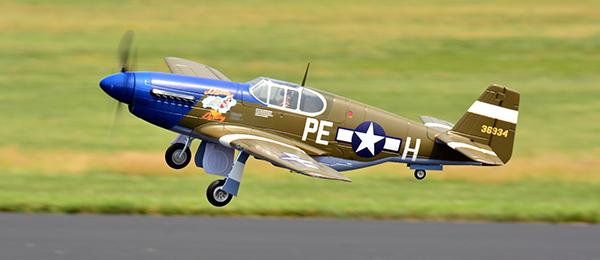
Review and video by Jay Smith Photos by Jay Smith and Jennifer Orebaugh This EPO foam fighter is a darling Featured in the September 2013 issue of Model Aviation magazine
Shenzhen Famous Electronics Tech Co. (FMS), founded in January 2007, has a reputation for manufacturing detailed, large, electric-powered foam warbirds. Known for continually refining its aircraft, the FMS 1400mm P-51D Mustang is on revision seven! The new 1450mm P-51B models are outfitted with all the upgrades including a removable battery tray, metal landing gear, and additional scale detailing. I’ve seen many FMS aircraft at trade shows and flying events, and heard positive comments from the pilots who own them. I was eager to add one to my hangar and was drawn to the P-51B Dallas Darling. I chose the B version because it is modeled less often than the D, and I had never seen Captain Henry White’s Dallas Darling scheme done before. If you’re looking for a more common scheme, the FMS P-51B is also offered in Don Gentile’s Shangri-La scheme. Captain White flew 89 missions with two aerial victories. His picture with Dallas Darling can be found in the book 352nd Fighter Group by Tom Ivie. But enough with the history lesson! It’s time to get this model to flightworthy status!
Assembly
I don’t normally comment on the box or the packaging, but this time I will make an exception. The model arrived from Motion RC, a new company that stocks FMS models, parts, and accessories. It came double boxed and the inner box caught my attention. Not only was it well illustrated with excellent photos of both versions of the P-51B, it proudly stated that 70% of customers would receive a free gift. I wondered if I would be lucky and what kind of gift I might receive. I was lucky and my gift was another set of blades for the propeller! I found a quality-control sheet with the following checked off: servo response check; motor and ESC check; power-on check; glue check; appearance check; and accessory package check. Quality control checks are good, but I was perplexed regarding the glue check. The FMS product page for the P-51B clearly states, “Assemble the whole airplane without glue,” yet, a tube of glue is included in the box. Reading the manual thoroughly before assembly, I found that the glue statement is technically true. You can completely assemble the model and fly it without using of glue; however, the exhaust stacks, machine guns, wing fillets, and antenna all require glue and I can’t imagine anyone purchasing this beautiful model and leaving them off. I laid out the parts for a photo and closely examined them. Although foam models have several advantages, their ability to withstand hangar rash is not one of them. The only real blemishes I found on the Mustang were a few small marks on each wing and a tiny spot at the rear of the fuselage. Overall, it looked fantastic!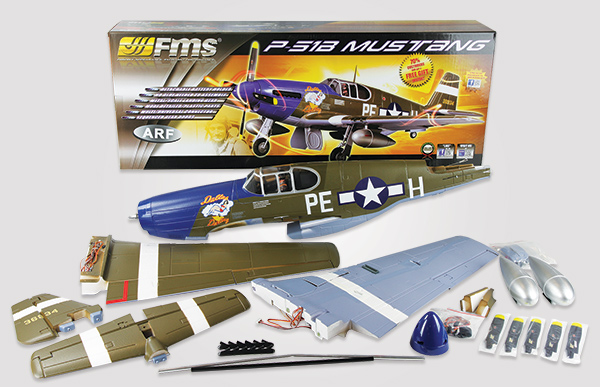 The Dallas Darling looks good out of the box. A few small marks on each wing and a tiny spot at the rear of the fuselage were the only blemishes.
The Dallas Darling looks good out of the box. A few small marks on each wing and a tiny spot at the rear of the fuselage were the only blemishes.
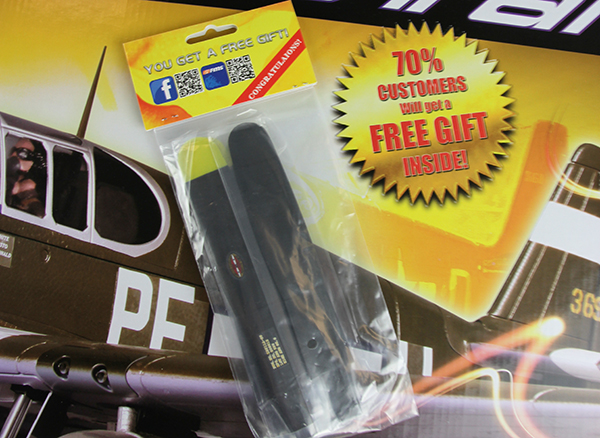 I was lucky and my gift was another set of blades for the propeller!
I was lucky and my gift was another set of blades for the propeller!
I will touch on some points of the assembly. The hardware comes in one plastic bag, with several smaller parts bagged within. This differs from the manual which states they are attached to the bags that hold the rudder, elevator, and other components. The first step is to attach the control horns to the control surfaces including the rudder, elevator, ailerons, and flaps. The manual points out that the longer screws are to be used on the LEs of the control surfaces. Each control surface has a clearly marked corresponding bag containing its hardware. An extra screw is provided for each size of hardware in the package, so if it contains two sizes of screws, you will find two extra. You’ll appreciate this the first time you drop one! The control horns have raised holes on one side of each of the two parts that screw together. This helps keep them in place on the opposite sides of the control surface when fastening the two screws.
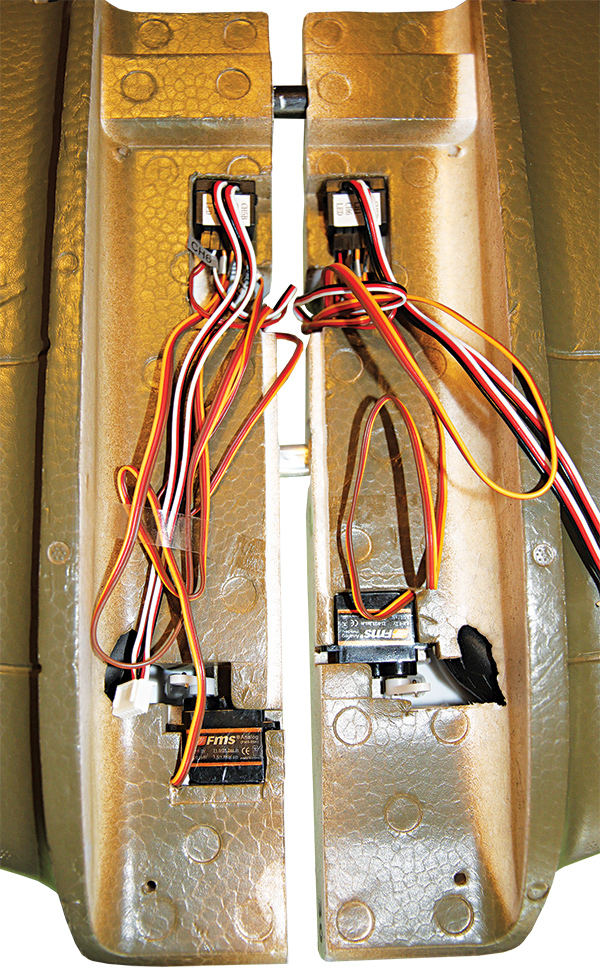 The wing uses two spars to attach the wing halves. The aluminum front rod is bent to provide the proper amount of dihedral. The carbon-fiber back rod was marked in the center with a silver Sharpie to ensure that when the wings are pushed together it is distributed evenly.
The wing uses two spars to attach the wing halves. The aluminum front rod is bent to provide the proper amount of dihedral. The carbon-fiber back rod was marked in the center with a silver Sharpie to ensure that when the wings are pushed together it is distributed evenly.
Two spars attach the wing halves. The aluminum front rod is bent in the middle to provide the proper amount of dihedral. The back one is carbon fiber. I marked the center of the back tube with a silver Sharpie to ensure that when the wings are pushed together it is distributed evenly. The easiest way to join the wings was to insert one rod in each wing half. Because the front rod is bent, it needs extra care when sliding together. The wing halves are held together by a front and back wing bolting plates. The wing bolts pass through these into the fuselage when you mount the wing. I decided to glue the wing halves together for additional strength using Beacon Foam Tac, a contact adhesive. Gluing the wing halves together is not mentioned in the manual because no glue is required for assembly, remember? Before gluing the wing haves together, I dry fitted them, connected my receiver, and tested the retracts, flaps, and lights. When I confirmed that everything was working properly, I glued the wings together and inserted the wing bolting plates to hold the wing together while the glue dried.
 The servo cover was removed to show the retractable tail wheel and sequenced doors.
The servo cover was removed to show the retractable tail wheel and sequenced doors.
The tail is assembled in two parts. The horizontal stabilizer plugs into the rear of the fuselage and is held in place with a screw. The vertical fin then attaches to the fuselage. When attaching the fin, be sure the bottom of the rudder slides into the hinge on the fuselage tail, which provides additional support. The vertical fin is held in place with two screws through the bottom of the fuselage. The control rods are threaded at one end and come with nylon clevises attached. The ones for the ailerons and flaps use a Z bend at the other end that attaches to the servo horn. On the rudder and elevator, adjustable connectors are used on the servo horns and are pretightened with the control rods attached. I slightly adjusted the elevator’s clevis so that it aligned with the control horn. This could also be done inside the fuselage at the control horn. Holding it where it exits the fuselage as I turned it, I was surprised when the adjustable connector on the servo arm snapped. It broke above the nut that holds it to the servo horn. I replaced it and checked the connector for the rudder which appeared to be fine.
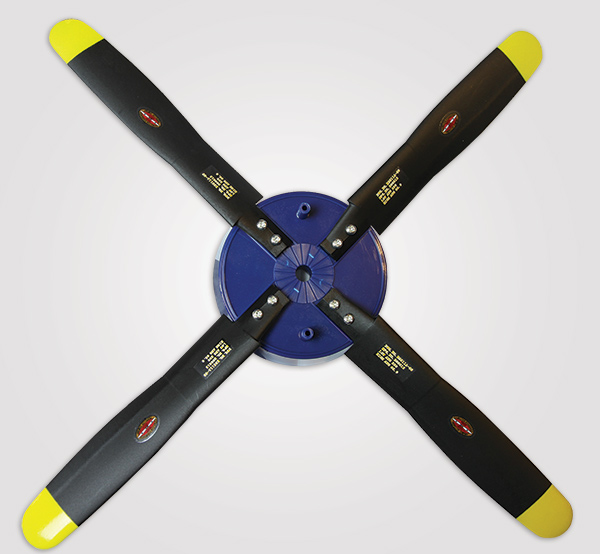 This beautiful propeller requires little work to have it ready to fly. The propeller blades are attached to the spinner backplate using two screws and nylon locknuts. A spare blade is included.
This beautiful propeller requires little work to have it ready to fly. The propeller blades are attached to the spinner backplate using two screws and nylon locknuts. A spare blade is included.
An attractive, four-blade propeller is provided and is used in flight. A spare blade is included. The propeller blades are attached to the spinner backplate using two screws and nylon locknuts which are inserted into the back of the backplate. I used a small piece of masking tape on each set to hold them in place while attaching the blades. I attached the exhaust stacks, machine guns, wing fillets, and antenna mast with Beacon Foam Tac. The included glue would probably have worked fine, but I felt comfortable using a familiar product.
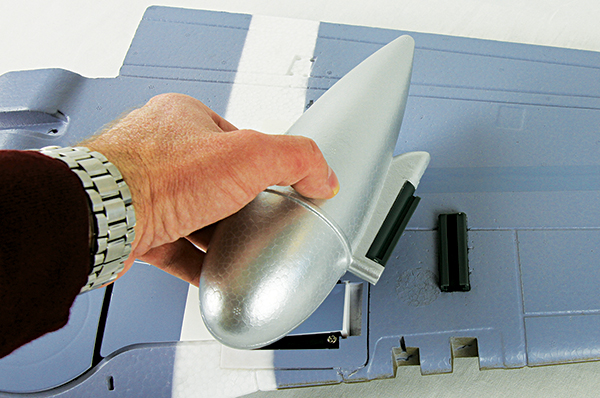 The drop tanks are easily installed or removed for flight and static display. Flying with the tanks on had no noticeable effect on the handling of the aircraft.
The drop tanks are easily installed or removed for flight and static display. Flying with the tanks on had no noticeable effect on the handling of the aircraft.
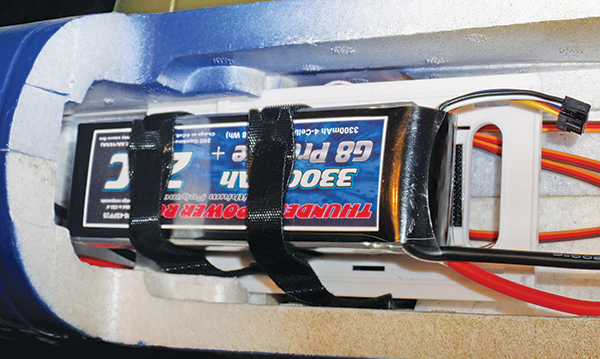 The removable battery tray provides easy access for battery swaps. Insert it into the groove and slide it forward until it locks in place. The Thunder Power 4S 3,300 mAh battery balances easily and provides good flight time.
The removable battery tray provides easy access for battery swaps. Insert it into the groove and slide it forward until it locks in place. The Thunder Power 4S 3,300 mAh battery balances easily and provides good flight time.
The last detail was to slide the two drop tanks onto the mounting racks and apply the provided decals using the guide in the manual. The supplied ESC has a nice safety feature; however, if you don’t read the speed control manual, it may seem confusing. The ESC will not arm the motor until it calibrates with the throttle on the transmitter. This is done by turning on the transmitter and putting the throttle stick all the way up (full throttle). Next, plug in the battery wait for the beeps and then move the stick to the bottom. The motor/ESC will then beep for the number of cells and arm. This only has to be done once. The manual’s instructions for locating the CG can be confusing. It instructs one to mark the location of 4.3 inches (110mm) back from the wing’s LE on the top of the wing. Then the instructions state to support the model with your fingers on the bottom of the wing. I believe they intended for the model to be balanced inverted, with the gear down and the drop tanks attached, if they will be carried during flight. The balance point I am using is the extreme front edge of the two small, circular indentions in the top of the wing found in the white striped portion. These make for an easy reference point. To obtain the proper CG, I had to mount my Thunder Power battery with the end of it hanging off the removable tray in the front. The manual provides a high-rate and low-rate settings. My throws are currently set between the high and low rates with 20mm on the elevator, 25mm on the ailerons, and high-rate rudder in each direction. My flaps are 18mm for mid and 35mm for full. Exponential on the elevator, rudder, and ailerons is set to 25%.
Flying
The P-51B taxis well, thanks to its steerable tail wheel, and can easily be “driven” to and from the runway. Using half flaps on takeoffs seems to work best. When under power, be prepared to input rudder corrections until the tail comes up. After that, little input is required. High-rate rudder with exponential is recommended to counteract torque and wind. Once in the air, it’s fun to flip the retract switch and watch the main gear and tail wheel retract and the gear doors close. On the first pass you will also appreciate the cool look of the big spinner and four-blade propeller. Remember to raise the flaps and put this beautiful aircraft through its paces. The FMS Mustang is capable of more than a victory roll and loops from level flight; it can fly the Split S, Cuban 8, and reverse Cuban 8. It even does a decent snap roll for a warbird. When inverted, only slight down-elevator is needed to hold level flight. Having 25mm of throw on the ailerons provides a nice roll rate. Adding a bump of down-elevator when inverted helps to keep the rolls axial.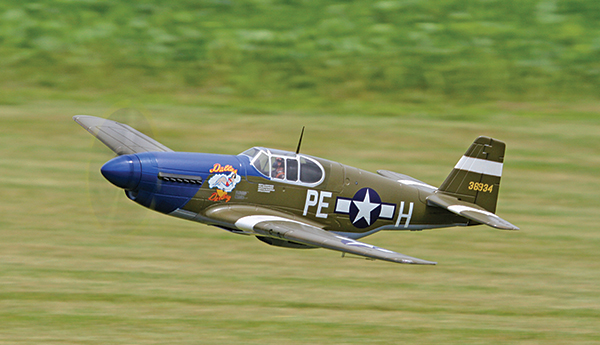 The FMS P-51B looks fantastic in the air. The four-blade propeller and the retractable gear with sequenced doors make this model stand out, even at full throttle!
The FMS P-51B looks fantastic in the air. The four-blade propeller and the retractable gear with sequenced doors make this model stand out, even at full throttle!
The Dallas Darling is a nice-looking model that deserves a few passes down on the deck at full throttle with a victory roll at the end for everyone to appreciate. It certainly puts a smile on the pilot’s face! When it’s time to bring it home, deploy the landing gear and employ either mid or full flaps. A gear pass before landing is a good idea to confirm the gear is down and locked. The flaps deploy at a slow, scalelike speed that prevents the model from ballooning. Full flaps will slow the Mustang for landing, but be sure to use full power until touchdown. Landing on the main gear is recommended; trying a three point landing will likely cause the model to bounce. If you do make a less-than-perfect landing, you’ll appreciate the shock-absorbing oleo struts on the main gear.
Conclusion
The FMS P-51B Mustang from Motion RC is a bargain at $279.99. It is a highly detailed model that includes retractable main gear and tail wheel, sequenced retractable gear doors, flaps, lights, oleo struts, and a pilot figure. The removable cockpit hatch provides easy access to electronics and implementing the removable battery tray makes battery swaps a breeze. The battery won’t shift in flight. Although it requires a little rudder work on the ground, in the air the Mustang provides warbird thrills in a beautiful and inexpensive EPO foam package. I am impressed with the level of detail packed into this semiscale fighter and it has certainly garnered attention on every trip to the flying field. —Jay Smith [email protected]Video Review
Bonus Photos
Specifications
Model type: Semiscale plug-n-play (PNP)Skill level: Beginner builder; intermediate pilot
Wingspan: 57 inches
Wing area: 600 square inches
Airfoil: Symmetrical
Length: 49 inches
Weight: 5 pounds
Power system: 4250-Kv540 brushless outrunner motor (included); 65-amp ESC (included); four-cell 3,000-3,600 mAh LiPo battery
Radio: Minimum six-channel radio
Construction: EPO foam
Covering/finish: Decals on detailed paint scheme
Street price: $ 279.99
Test-Model Details
Motor used: 4250-Kv540 brushless outrunner motor (included)Battery: Thunder Power 4S 3,300 mAh 25C
Propeller: 14 x 8 four-blade propeller (included)
Radio system: Futaba 8FG radio; Futaba R617FS seven-channel receiver; six 9-gram and three 17-gram servos (included)
Ready-to-fly weight: 5 pounds, 7.5 ounces
Flight duration: 7-plus minutes
Pluses
• Highly detailed and easily assembled.• Removable battery tray.
• Extra hardware included.
• Retractable main gear and tail wheel with sequenced gear doors.
• Working lights and flaps.
• Detailed instruction manual.
Minuses
• Elevator servo connector needed replaced.• Instructions for balancing can be confusing.
Manufacturer/Distributor
FMSwww.fmsmodel.com
Motion RC
(224) 633-9090
www.motionrc.com
Sources
Futaba(800) 637-7660
www.futaba-rc.com
Thunder Power RC
(702) 228-8883
www.thunderpowerrc.com
Similar Articles
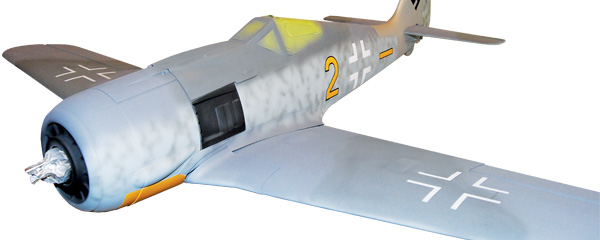 |
Scale Modeling Written by Rob Caso 13 video tutorial |
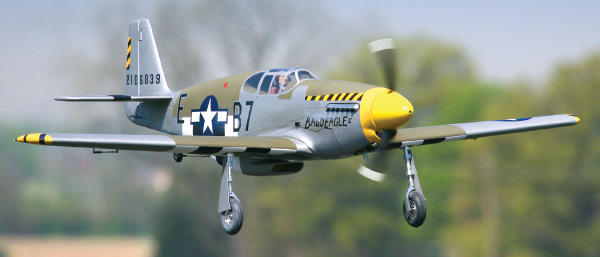 |
ESM P-51 B Mustang ARF Written by Tom Sullivan Find the entire feature on page 59 in the August 2010 issue. Watch a video as Tom Sullivan finds room for a rarely attempted scale detail. |
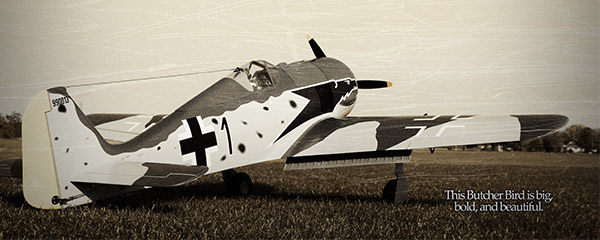 |
Focke-Wulf 190 Written by Tom Sullivan Review highlights, build video, and flight video As featured on page 40 in the January 2013 issue of Model Aviation |










2 comments
FMS P51B Article
No video
Add new comment